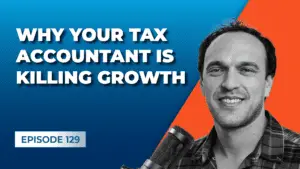In our previous episode, we shared five different types of budgets you can use to understand the finances at your company. While these budgets can do a lot to shape the way people think about your company’s finances, they won’t do much good if they don’t lead to action.
Today we look up from the numbers and look around at the office space. We’ll share some of our best advice about what it will take to actually implement these budgets in your company.
On this episode you’ll hear
- Why you need buy-in from senior management
- The importance of accountability
- How your budgets should be used to set targets
- Best practices for reporting this information
- The importance of action
If you’re looking for some help turning your budgets into shared practices at your company, then this is one episode you won’t want to miss!
Resources
Transcription of This Episode
The Gross Profit Podcast is your one-stop shop on the path to profitability. Each week, we share authentic advice on the positive, practical steps you can take to make the company you love more profitable. If you’re looking for a positive plan to help you avoid common spending mistakes, control costs, and increase your profits, then this is the place for you.
I’m Ryan Cowden, and this week we’re joined by James Kennedy and Garrett Carragher. In this episode of the Gross Profit Podcast, James and Garrett shared the strategies you need to implement your budgets at your company. In our previous episode, we shared five different types of budgets you can use to understand the finances at your company. While these budgets can do a lot to shape the way people think about your company’s finances, they won’t do much good if they don’t lead to action. Today, we look up from the numbers and look around at the office space. We’ll share some of our best advice about what it will take to actually implement these budgets in your company.
On this episode, you’ll hear why you need buy-in from senior management. The attitudes of senior management will affect the rest of the company, so take the time to make sure that they’re all on board with the new plans.
Next, we’ll discuss the importance of accountability. Clearly identifying what the budgets are, and who is accountable upfront, will go a long way and keeping your managers and their teams on board with the budgets you’ve drawn up. Then, we’ll talk about how your budgets should be used to set targets. To get the best performance from your teams, the targets you draw up should be both challenging and attainable. We will also share some of the best practices for reporting this information. Using short reporting periods, and moving information quickly, will give your managers the time they need to analyze this information and draw up a proper response.
And finally, we’ll discuss the importance of action. Successful budget meetings should clearly define paths of action, so that the issues brought up will be addressed in practice. If you’re looking for some help turning your budgets into shared practices at your company, then this is one episode you won’t want to miss. There’s a lot of actionable advice in this episode, so grab something to write with because you’re going to want to take notes. As always, I’ll be back on the other side to wrap up any loose ends, so without any further ado, here’s our conversation with James and Garrett.
Hello. It’s James Kennedy here from Procurementexpress.com, where we help hundreds of companies, safely spend billions of dollars each year. I’m joined once again by the secret CFO, Garrett. How were you on this fine Sunday morning?
Good James. Good to talk to you as always. A very successful and a very interesting topic today. We’re going to talk about successful budgeting. I can’t wait to speak about this. I know it’s part two of our series. It should be very exciting and very useful for our listeners.
Well, would you believe it if I told you that we had a huge response from part one last week; emails and text messages about the five types of budgeting? So people can go back and refer to that.
Yeah, it doesn’t surprise me at all. It was very exciting and people should definitely listen back to it, to understand. Because it is part of a series, you should always listen back to the start of a series and follow it through.
Part two is going to be the interesting bit though. We’re already going to get into the nuts and bolts of, you’ve gone through the work of creating your fancy, static or zero-based eroding or incremental or flex budget. It’s in a beautiful spreadsheet where everything’s perfect and nothing ever goes wrong. Next thing, it has to hit the reality of the world. So, you’ve implemented a ton of these budgets Garrett. What’s your advice for getting your spreadsheet implemented if only that people would do what they were told to do?
Exactly. Yeah. Well, I think there’s about… I usually have… I have here about seven tips I have, that are thought up basically on how to do a success budget. So these are the ones that you need to really think about before you go off and as you do your budget. I think in part three next week we can definitely go through an actual budget. We can go through some numbers or we can have a look into detail and I shall have a spreadsheet download for people who want to actually download a budget template and started using that themselves for their own budgets.
But in this one I’d like to speak about, what do you need to do? How do you need to prepare for it to make sure your budget is going to be successful? Because in so many cases a budget gets done and then no one ever looks it again; so sad. So we need to make sure it is something that people are going to look at and people are really going to use it and deliver it going forward.
So the first thing is you need… And this is super key in a lot of things James, is you need to have a buy-in from the senior management, and they must take the budget and process seriously. So they need to help you with actually lining up the people to sit down with you to do the budget.
In some smaller businesses it’s quite easy, but in a bigger multinational business, you can get people who really do no work on a daily and yearly basis. And it’s very hard to get them to engage in this kind of process, they really don’t care. They’re not… If you’re their estate accountant, they’re not really countable to you and they just don’t care. And it’s very hard to get them in.
Well, the leverage point, I’d say for the management is, I mean you have to sell it to them, right? And this is key really. If you don’t have the budget, you won’t be able to get ahead of your spending decisions. You won’t have a target. I guess we’re all on board with having targets. Last week we talked about the budgets actually are more like targets and that also they have to be achieved in order for the company to be successful. So if you maybe, actually, if you’re… I would say you can get buy-in more if you say, “Well these are really targets for the success at a company.” Because budgets, I think something about the word, people… I guess is constrictive or they don’t… Maybe they think they’re going to be controlled or something. But if you set a target that’s more like aspirational, so yeah.
That’s a pretty good point James. Yeah, a target can be more aspirational, and it’s open to people who want to hit, they want to hit a target. Whereas a budget might feel constraining and usually means you can’t spend money. And that’s the way people think about it. So in this case, when you’re initially starting off the budget, you need to get that buy-in from the senior management. You can say this is a target. We want to hit this target. Our budget, our target for our profit is this number. And they want to hit it. They want to get their money and get their pay raise or whatever. So they are going to be very… And want to keep their jobs. So they’re going to be incentivized to deliver that.
And importantly, that kind of attitude will cascade down through the rest of the business. So if the MD comes out and says, “The finances are working on our budgets, which are our targets for next year, everyone has to take this seriously. It is critical we hit these numbers. Engage with these people and make sure you get numbers in that are credible and make sense.” And once you do that, once the senior management comes out like that, even with anything, senior staff with any kind of change or implementation or new rules or anything in the business. It can have a huge effect and everyone takes it much more seriously. So yeah, buy-in from super management is super important.
Second point then is the famous accountability. So you really have to have clear responsibilities for what each manager is responsible for. Which department, which area, which sector, which products, which employees, what it’s delivering. Because this is where the lazy manager can hide in ambiguity, in stuff that’s gray, it’s not black or white. “Was I really responsible for the sales of that product? I don’t think so. Was it not Billy Bob down in the corner or down the corridor in the office, down there? I think that was his baby. It wasn’t mine. Why is it in my budget? What does it got to do with me? Take it out, move it elsewhere. That employee, he’s not my cost, he should be costed elsewhere. He’s a central cost.”
That’s the word I always hear. And I do and I laugh and I love to hear. It’s so funny. Everyone will put everything in central cost. There is a magical pocket to call it central costs, where everyone should be except for one fella who sells stuff. Everyone else is hidden away in central cost. They don’t want the cost.
So the smart manager… This is a tip for the smart managers out there who already know this probably, is to keep your budget or target as low as possible, so you can hit it in your sales and then get rid of many costs as you can. So, if there’s any kind of costs in there that’s half way available to another department, so you might say, “I have an employee here. He does work for my department but actually, doesn’t he do a bit of work for the other fellow down there in the Ops department down there? Does he do a bit of work for that fella or for that region for the South region of the U.S.? Does he do a bit of work for that? I think 50% his cost should be built in there as well.” So-
What’s your policy there? Do you just say, “No, that’s it, one person, one department.” Or do you start allocating 50 people 50% and 20% here or there?
I allocate people. And the reason I allocate people is the most important thing, as we’ll probably come to one of our points here, one of our later points, is that costs are in the right place, the most important thing. But you must have buy-in from the managers. So if you’re hitting the manager with a cost that’s not his cost, he’s immediately, every meeting you go to, he’s going to say it here or she’s going to say it here, “Yeah, when I’m behind 5%, bought, every meeting, bought, you’ve costed in here, Billy Bob. Billy Bob only works 50% of the time for me. He spends 50% of his time in sales. Why are you put him in here? He’s nothing to do with Ops. He’s not in Ops. He shouldn’t be in here. If I take that out, I’m only 2% behind.”
And that’s what they constantly do. Constantly try and absticate I think is the word, is it? And try and hide and try and move it around and to have discussion about something else. They don’t want to discuss the real problem. As much time as they can spend discussing why the numbers are wrong, it means less time discussing why they haven’t done their job. It’s as simple as that.
So you just get them to buy-in at the beginning. He’s 100% sure of cost, even if he works for someone else. That’s just the way it is. You got to work with that.
Well what you want to do is, you want to get the cost in the right place. So if someone is 50% here and 50% there, you need to reflect on the budget. But then once that’s done, that’s it. You know, she’s saying, “Move on, it’s done, let’s move on.”
So the next step, the next point we need to have, to have a successful budget, is the targets need to be challenging, but they need to be achievable. So there’s no point in gearing your sales team, “You need to hit a 100% growth next year or in month one.” It’s just rubbish. They’re not… Or unless you’re on Facebook, they’re not going to do it.
So you need to have something that’s achievable that incentivized them to go for that target. Or if they don’t hit it, then they really should have hit it. And you can say, “Well look, why didn’t you hit it? Explain to me in detail why you didn’t hit that number? That number what was achievable. We both know it’s achievable. Why didn’t you hit it?”
Okay, very good. So it’s got to be something that’s challenging. This is where you maybe come in with your a 5% gross or whatever your target is, plus something that’s believable. It’s not believable if no one’s going to try in the first place.
Exactly. And the secrets that I always use James, is a good secret now from the secret CFO, is I always get them to think they come up with the number.
Right?
So I sit down with them, and I run through the numbers and then I would say to them very clearly and show them on a spreadsheet. “If I take your number of people by your selling price per person”…Say this is a service business. “If take your number of people by your selling price per person, by the utilization, the number of hours to work in the month, multiply that, all right. That numbers coming up to and that person’s going to bring in revenue of 200,000 in the year. Isn’t that right?” And they go, “Yeah.” I go, “Well, if I do that for all your people, and add up all your revenue for the year, it’s going to be 2.8 million. It does not make sense. You can see it there. It’s adding up there isn’t it?” And they go, “Yep.” And you can say, “You’re happy with utilization?” “Yep.” “You’re happy with the sales number?” “Yep.” “You’re happy with whatever there?” “Yep.” “Well I think that’s your number then. That’s the number for the years, 2.8 million and that’s it.”
And they buy into it. Then they go off and they can understand where the numbers came from. You have to be good at your job James. There’s no point in sitting down a spreadsheet and typing in 2.8 million as your number hiatus. You know, that’s just not credible. And it shows you don’t know what you’re doing. Whereas if you can build up the number and work through with them and it goes make sense, you know?
That’s a pretty powerful whim.
It is powerful. It is. And they really have to… They really can’t shy away from it. And obviously you don’t want to go the other way. If your target is too low as well. Both of those really overall help. The motivating effect. So that would mean your target’s too high. “I’m not going to hit that. I’m missed it every month. I’m not going to bother. I don’t care. Right? Target’s too low, you’re hitting it every month. You’re riding the golf course, you don’t care. I go into another sales meeting to hit this challenging target, James. As he hits four, as he hits the ball, then the fairway, you know and you go, “What the hen?” So that’s the third point. It has to be achievable.
Point number four… And I think this is something that maybe we can all reflect on in our businesses, is that we need good reporting. You really need good reporting. So you need to get targeted reporting that will give good information back to the managers, and in a timely way, quickly on is accurate. And that will allow them to get the feedback and make the adjustments as necessary. Otherwise-
When you say that, does that mean a morning email from garage with what the budgets are for that day? Or how do you achieve that?
So the way I do it is actually in the next point. So I’ll bring that into this point as well. So you need to have short reporting periods, you know, so usually the way we doit, and the way most businesses do it, it’s usually about a month. So there’s no point in going six months down the line, looking at your actions versus your budget and going, “And you’re off here by 300,000.” And they go, “Well I’m not going to make that up in six months, so that’s the end of that.” So each month, you know, a period of time, is usually maybe a calendar month. Or some people do four, four, five; four weeks, four weeks, five weeks, something like that.
But usually you can have a calendar month, and you need to get to pick calendar month. You get your can stone as quick as you can; after a month, then usually within three to six days. And then you sit down and let the managers… Make sure they go through the numbers to understand the numbers. And then I think an important thing to do is get the managers to present the numbers to the MD or to the senior management team. And they come in and say, “Here’s my numbers.” And then the MD gets to question them in an objective way. I think that’s important to have that kind of a split there. You know the MD is not making up the numbers with the managers. He’s separate or she’s separate and they’re looking at the numbers and then they are allowing them to delve into them. And make sure that their managers understand the numbers.
So I wouldn’t… And so in your example there, would you do something every day? No, that’d be bonkers. Maybe for the… In your case you might have someone who’s doing… Who’s saying there’s number of calls that need to be done in a day or number of leads that need to be followed up or the number of people that need to be signed up in a week. And that will be super useful to report that to your sales call team and say, “Are you making these calls? You’re not doing enough calls. We know that we have to do a hundred calls a day, a hundred calls gives us so many leads, gives us so many signups .
So that would be useful in that context. But when we look at budgeting on a much higher level, we are looking at an overall thing. So once a month it’s usually enough.
Pretty good. Okay. So I can see that. And of course I should mention if you’re using a tool of like www.procurementexpress.com you can get real time budgets. And you can get budgets, up to date budget information every time you make a purchase in advance of the purchase. Before you use a budget, you’re able to see what’s left there. So that’s helpful. Might as well get that plug-in since it’s germane I think.
Okay, what have you got? Let’s see, what’s the final point?
Two more points. Two more. And so the next point then is, I think I’ve kind of covered there as well. So we’re talking about reporting over these three points. So we talk about target reporting. So it’s for the managers, and it covers off what’s relevant to them. We’re talking about short periods. So we do it every month and we follow it up. And then finally we tell them a timely reporting. So we need to get the variance analysis on all the variants reports to the managers as quick as we can after the end of that month. So again, we’re not talking about, you know, three weeks in, we get in a variance analysis back to the manager saying what’s going on. We’re talking more like three to four days, three to five days, something like that. You’re staying… You’re getting back to the managers.
So at the end of the month is the end of September and maybe by the 4th, the 5th of October, the manager’s getting report into her hands to tell them how they’re doing and all the various analysis. And then that gives them a day or two to analyze and think about that and go back to accounts and really go through it. And then they finally maybe day or two after that, they’re report that then to their own MD and say… Or the MD would probably get the numbers anyway from the finance person or department. Or the MD can call that up then with the managers and walk through that with them. And the manager should be able to give them good feedback and where they’ve gone right or where they’ve gone wrong.
And finally then, the last point we have of our seven budgeting tips for successful budgeting, is to all this really leads to action on it. That’s what we all say. Everything must lead to action. So if we do our budget, we compare it to our actuals… Successful budgeting means that people take action based on the variances; they actually make a change. So there’s no point in seeing that last month our team have done too much in overtime, and they’re not doing enough sales. You need to make an action on that. You need to go into your sales team and either say, “There’s no more overtime.? Or, “The overtime needs to deliver sales.” Or, “Why is there so much overtime? What’s going on? Why is this?”
Understand it in depth. Because the numbers again are just giving you information and you need to make an action on the information. So the action in that case might be, “We’re short a staff, some fellow’s gone sick, out a month. And maybe taking them to Michael and it’s time to move him on to a different place and a happier location from SAPs, which is not this business. We will hire in someone else, who will deliver on our sales and get us back on track.” Reduce overtime, reduce our costs, and increase our sales. So that’s our seven tips there. And we might stick a link in or something to those seven tips onto our website where they can have a look at that.
Yeah, I think so. Let’s say… I think I’ll ask the team to put this into a blog post for us, because there’s good stuff here and we’ll link that up on the podcast as well.
Cool. Good stuff.
So Garrett, that’s fantastic. And more practical advice from the secret CFO. You cannot buy this advice. You cannot buy it. It’s very priceless and you’ve reinvigorated me and enthused me of going back and getting my budgets implemented. So thanks for that Garrett.
No worries. Thanks James, talk to you again soon.
Talk to you soon. Bye bye.
Bye.
All right folks. There you have it. That wraps up our conversation with James and Garrett. They shared a ton of valuable insights and advice today on how to put your budgets into practice. We also shared some tools and resources, which will all be linked up in the show notes. Don’t forget to click on one of those links to get a free chapter from the book Profit Leaks by James Kennedy and Garrett Carragher. We hope you enjoyed our conversation. Please consider subscribing, sharing with a friend, or leaving us a review in your favorite podcast directory. Until next time, best of luck in all that you do. And we’ll look forward to seeing you on the next episode of the Gross Profit Podcast.




